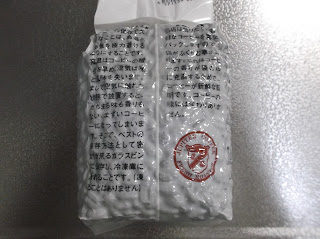Today, I went to Nagaoka by train. My main purpose was to go to the school festival held at my son's high school, but I was looking forward to doing some shopping in Nagaoka.
It's a one-hour ride from Shiozawa Station to Nagaoka Station, and I bought these on my way to Shiozawa Station to quench my thirst.
今日は長岡に電車で行きました。主な目的は息子の高校の文化祭に行くことでしたが、長岡で買い物をするのを楽しみにしていました。
塩沢駅から長岡駅までは1時間なので、塩沢駅に行く途中で、渇きを癒すため、こんなのを買いました。
Roots Aroma Black (black coffee with no sugar) and Black & Black (gum).
Roots Aroma Black(無糖のブラックコーヒー)とBlack & Black(ガム)。
This particular canned coffee is quite drinkable. (Ten years ago, almost all canned coffee brands were hardly drinkable.)
この缶コーヒーは、かなり美味しいです(10年前は、ほとんどすべての缶コーヒーは飲めたものではなかったです)。
I had Yasuda Yogurt soft-serve ice cream in the food court in the Nagaoka station building. As I mentioned previously, the best soft-serve ice cream I've ever had.
長岡の駅ビルにあるフードコートでヤスダヨーグルトのソフトクリームを食べました。前にも述べたように、今まで食べた中で一番美味しいソフトクリームです。
250 yen.
250円です。
I had no food at the school festival. I'm still on a diet. Last year, I had just a lot of foods at the festival as I described here.
文化祭では食べ物は何も食べませんでした。まだダイエット中です。去年はここで述べたように色んな食べ物を食べましたが。
At the supermarket in the station building, I bought these:
駅ビルのスーパーでは、こんなものを買いました:
Potato snack and Aki Aji (Autumn Flavor) beer.
ポテトのスナックと秋味ビール。
This particular brand is available around this time of year.
この銘柄は一年のうち今頃しか買えません。
Here are some of the items I bought in Nagaoka.
長岡で買った物の一部です。
At Marcian (bakery), I bought bread called Dan.
マルシャン(パン屋)では、暖というパンを買いました。
Good enough, but I still prefer Muku.
美味しいですが、無垢のほうが好きです。
Wines, green coffee beans (Brazil), roasted coffee beans (Mocha), Lotus biscuits, and prunes.
ワイン、コーヒーの生豆(ブラジル)、焙煎したコーヒー豆(モカ)、ロータスビスケット、プルーン。
Close-up of the green coffee beans:
生豆のクローズアップ写真:
I will roast them myself.
自分で焙煎するつもりです。
Bag containing Mocha coffee beans:
モカのコーヒー豆が入った袋:
This particular bag explicitly says that you transfer the beans in an air-tight glass jar and store in the freezer.
この袋には、気密性のあるガラスビンに移し、冷凍庫に入れると書かれています。
Lotus Biscuits:
ロータスビスケット:
Very good!
とても美味しいです!






































